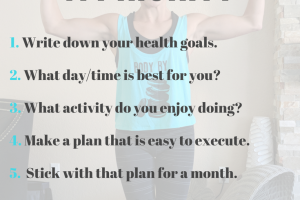The Power of Simplicity: How to Prioritize Health in Your Life

Understanding the Importance of Prioritizing Health
In today’s fast-paced world, it’s easy to put health on the back burner. However, prioritizing one’s health is crucial, as it serves as the foundation for a fulfilling life. When individuals make health a focus, they often notice improvements in their energy levels, mood, and productivity. For instance, a friend of mine, Sarah, decided to invest time in her health by adopting a morning routine that included exercise and nutritious breakfast choices. This shift not only boosted her physical health but also enhanced her mental clarity throughout the day.
- The Power of Simplicity: How to Prioritize Health in Your Life
- Understanding the Importance of Prioritizing Health
- Benefits of Simplicity in Health
- Assessing Your Current Health Status
- Identifying Areas Needing Improvement
- Setting Realistic Health Goals
- Simplifying Your Diet
- Incorporating Nutrient-Dense Foods
- Meal Planning for Health and Convenience
- Streamlining Your Fitness Routine
- Finding Physical Activities You Enjoy
- Creating a Sustainable Exercise Plan
- Embracing Mindfulness and Stress Management
- Practicing Meditation and Relaxation Techniques
- Cultivating Positive Mental Health Habits
- Creating a Healthy Sleep Environment
- Importance of Quality Sleep for Overall Health
- Establishing a Bedtime Routine for Better Sleep
- Building Supportive Relationships
- Surrounding Yourself with Positive Influences
- Setting Boundaries for Healthy Relationships
- Incorporating Self-Care Practices
- Prioritizing Self-Care Activities for Mental Health
- Finding Balance Between Work and Personal Life
- Monitoring Your Progress and Adjusting Accordingly
- Tracking Your Health Goals and Milestones
- Adapting Your Lifestyle for Long-Term Health Success
Benefits of Simplicity in Health
Simplicity can be a game-changer when it comes to managing one’s health. By simplifying dietary choices and exercise routines, individuals often find them easier to maintain. Here’s how simplicity can benefit health:
- Reduces Overwhelm: Cutting out complicated meal plans and workout regimes helps in staying consistent.
- Encourages Mindfulness: Focusing on fewer choices allows greater awareness of one’s body and well-being.
- Facilitates Better Decisions: A simplified approach fosters smart nutrition and fitness decisions, ultimately leading to sustainable habits.
In essence, prioritizing health and embracing simplicity can significantly enhance overall well-being.
Assessing Your Current Health Status
Identifying Areas Needing Improvement
Before embarking on a health journey, it’s essential to take a step back and assess where you currently stand. Identifying areas that need improvement can feel daunting, but it’s a necessary first step. For example, when my colleague Mark analyzed his daily routine, he discovered that he lacked sufficient hydration and often skipped meals. By pinpointing these habits, he was able to create action steps to address them. Here are a few areas to consider assessing:
- Nutritional Habits: Are you consuming a balanced diet?
- Physical Activity: How often do you engage in exercise?
- Sleep Quality: Are you getting enough restful sleep?
- Stress Levels: Are you effectively managing stress?
Setting Realistic Health Goals
Once you’ve identified the areas in need of improvement, it’s time to set realistic health goals. Goals should be achievable and specific to ensure motivation. Instead of vague aspirations like “I want to be fit,” consider:
- Eating three servings of vegetables daily.
- Exercising for 30 minutes three times a week.
- Establishing a wind-down routine for better sleep.
By framing goals in a specific manner, you can track your progress and celebrate small wins, making the journey to better health both manageable and rewarding.
Simplifying Your Diet
Incorporating Nutrient-Dense Foods
After setting your health goals, it’s time to simplify your diet by focusing on nutrient-dense foods. These are the foods that provide the most nutrition for the least amount of calories. For instance, when my friend Lisa shifted her focus towards foods like leafy greens, colorful vegetables, lean proteins, and whole grains, she noticed an incredible boost in her energy levels. To get started, consider incorporating:
- Leafy Greens: Spinach, kale, and swiss chard are fantastic sources of vitamins.
- Fruits: Berries, bananas, and apples provide both nutrients and natural sweetness.
- Whole Grains: Quinoa, brown rice, and oats keep you full longer.
- Lean Proteins: Chicken, turkey, beans, or lentils contribute to muscle health.
Meal Planning for Health and Convenience
Meal planning is a powerful strategy that not only simplifies your diet but also saves time and money. By devoting a little time each week to plan meals, you can ensure healthier choices are readily available. For example, set aside an hour on Sundays to cook and portion meals for the week ahead. Here are some meal planning tips:
- Choose a Theme: Designate specific cuisines (e.g., Mediterranean or Asian) to keep meals exciting.
- Prep Ingredients: Chop vegetables and marinate proteins to make cooking easier on busy nights.
- Create a Shopping List: Stick to it to avoid impulse buys.
By incorporating nutrient-dense foods and labeling meal planning as part of your weekly routine, you can effortlessly nurture your health while enjoying delicious meals.
Streamlining Your Fitness Routine
Finding Physical Activities You Enjoy
As part of your journey towards improved health, it’s crucial to streamline your fitness routine by focusing on activities you genuinely enjoy. When exercise feels like a chore, it’s tough to stay motivated. For example, James discovered that he loved dancing, so he joined a salsa class instead of forcing himself to hit the gym. This simple change made a world of difference! To uncover activities you might enjoy, consider trying:
- Group Classes: Spin, yoga, or kickboxing can offer a fun, social environment.
- Outdoor Adventures: Hiking, cycling, or jogging in the park connects you with nature.
- Dance or Martial Arts: These are enjoyable ways to stay active without feeling like a workout.
Creating a Sustainable Exercise Plan
Once you’ve identified activities you love, it’s time to create a sustainable exercise plan. The goal is to make fitness a regular part of your life without it feeling overwhelming. Here are key elements to include in your plan:
- Consistency: Aim for 150 minutes of moderate aerobic activity per week, broken down into manageable chunks.
- Flexibility: Allow for variations, scheduling workouts around your commitments rather than rigidly sticking to a set routine.
- Variety: Mix different activities to keep things fresh and target different muscle groups.
By incorporating enjoyable activities and planning for sustainability, you can build a fitness routine that feels rewarding and fits seamlessly into your lifestyle.
Embracing Mindfulness and Stress Management
Practicing Meditation and Relaxation Techniques
As you continue to streamline your fitness routine, don’t overlook the importance of mindfulness and stress management. Incorporating practices like meditation and relaxation techniques can significantly enhance your overall well-being. For instance, Laura found that taking just ten minutes each morning for meditation helped her tackle the day’s stressors with a clearer mind. To get started, consider trying:
- Guided Meditation: Apps like Headspace or Calm offer easy-to-follow sessions for beginners.
- Deep Breathing Exercises: Practice inhaling slowly for a count of four, holding for four, and exhaling for four to instantly calm your mind.
- Progressive Muscle Relaxation: Tense and release each muscle group progressively to release built-up tension.
Cultivating Positive Mental Health Habits
In addition to meditation, cultivating positive mental health habits is vital. Reflecting on your daily thoughts and behaviors can reveal areas for improvement. Here are some habits you can adopt:
- Gratitude Journaling: Spend a few minutes each day noting what you’re thankful for to shift your focus away from negativity.
- Setting Boundaries: Learn to say no to commitments that drain your energy.
- Regular Breaks: Incorporate short breaks throughout your day to recharge mentally.
By embracing mindfulness and cultivating mental health habits, you can create a balanced approach that complements your physical health journey, leading to overall wellness.
Creating a Healthy Sleep Environment
Importance of Quality Sleep for Overall Health
As we embrace mindfulness and stress management, it’s crucial to recognize the role that quality sleep plays in our overall health. Sleep is not just a time to rest; it’s a vital process for both the mind and body. For instance, when my brother made a conscious effort to improve his sleep quality, he noticed significant improvements in his focus and mood throughout the day. Quality sleep is linked to:
- Enhanced Cognitive Function: Good sleep helps in concentrating and retaining information.
- Emotional Well-Being: Sufficient rest can reduce anxiety and improve mood stability.
- Physical Health: Consistent quality sleep supports a healthy immune system and hormone balance.
Establishing a Bedtime Routine for Better Sleep
To improve your sleep quality, establishing a calming bedtime routine is essential. This not only signals your body that it’s time to wind down but also encourages restful sleep. Here are some steps to consider:
- Set a Consistent Sleep Schedule: Go to bed and wake up at the same time each day, even on weekends.
- Limit Screen Time: Try to avoid screens at least 30 minutes before bed to reduce blue light exposure.
- Create a Relaxing Atmosphere: Dim the lights, play soft music, or read a book to help your mind unwind.
By prioritizing quality sleep and establishing a bedtime routine, you’re putting one more essential pillar in place for a healthier, more balanced life.
Building Supportive Relationships
Surrounding Yourself with Positive Influences
As we focus on creating a healthy sleep environment, it’s equally important to acknowledge the role of supportive relationships in promoting overall well-being. Surrounding yourself with positive influences can have an uplifting effect on your mental and emotional health. For example, when Clara began spending more time with her encouraging friends instead of those who were overly critical, she felt a newfound sense of empowerment and happiness. Here are some ways to cultivate positive relationships:
- Seek Supportive Friends: Engage with those who inspire you, listen, and provide constructive feedback.
- Participate in Community Groups: Joining clubs or activity groups can introduce you to like-minded individuals.
- Limit Toxic Interactions: Identify relationships that drain your energy and consider investing time in healthier connections.
Setting Boundaries for Healthy Relationships
While building supportive relationships is key, setting boundaries is essential for maintaining your mental health. Defining what’s acceptable can help protect your emotional space. Start with these strategies:
- Communicate Clearly: Be direct about your needs and limits to others.
- Practice Saying No: It’s okay to decline invitations or requests that don’t serve your well-being.
- Evaluate Relationships Regularly: Reflect on whether your relationships uplift or drain you, and adjust accordingly.
By surrounding yourself with positive influences and establishing healthy boundaries, you lay the groundwork for supportive relationships that nurture your journey toward overall wellness.
Incorporating Self-Care Practices
Prioritizing Self-Care Activities for Mental Health
As we continue to build supportive relationships, it’s essential to emphasize the importance of self-care practices for maintaining mental health. Self-care isn’t a luxury; it’s a necessity. For instance, when my friend Paul took the time to prioritize self-care activities like painting and journaling, he noticed a significant shift in his stress levels and overall mood. To incorporate self-care into your routine, consider the following activities:
- Mindfulness Practices: Engage in activities like yoga or meditation to ground yourself in the present moment.
- Creative Outlets: Allow yourself to express creativity through writing, art, or music.
- Nature Walks: Spending time outdoors can uplift your spirits and recharge your mind.
Finding Balance Between Work and Personal Life
In the pursuit of self-care, finding balance between work and personal life is crucial. Setting clear distinctions will help you prevent burnout. Here are some strategies to create that balance:
- Define Work Hours: Stick to a specific start and end time for your workday to create boundaries.
- Schedule Personal Time: Just as you would a meeting, prioritize time for self-care and downtime.
- Practice Unplugging: Designate tech-free time, especially in the evenings, to unwind and focus on non-work activities.
By incorporating self-care practices and striking a balance between work and personal life, you not only enhance your mental health but also create a more fulfilling lifestyle.
Monitoring Your Progress and Adjusting Accordingly
Tracking Your Health Goals and Milestones
As you incorporate self-care into your routine, it’s essential to continually monitor your progress and adjust as needed. Tracking your health goals and milestones can provide you with a sense of accomplishment and clarity. For example, when Jenna started keeping a health journal, she noticed patterns in her eating and exercise habits, helping her refine her goals. Here are ways to effectively track your progress:
- Set Specific Milestones: Break your goals into smaller, achievable steps, like running an extra mile each week.
- Utilize Health Apps: Consider using apps to log meals, track workouts, and monitor sleep patterns.
- Celebrate Small Wins: Acknowledge and reward yourself for achieving milestones, no matter how small.
Adapting Your Lifestyle for Long-Term Health Success
Once you have a system for tracking, it’s crucial to adapt your lifestyle for sustainable success. Flexibility is key to maintaining your health journey. Consider these strategies:
- Review Your Goals Regularly: Adjust your objectives based on progress and any changes in circumstances.
- Be Open to Change: Experiment with new activities or dietary choices as you figure out what works best for you.
- Stay Informed: Continuously educate yourself about health and wellness to make informed decisions.
By monitoring your progress and adapting as necessary, you lay the groundwork for long-term health success and a fulfilling lifestyle.





